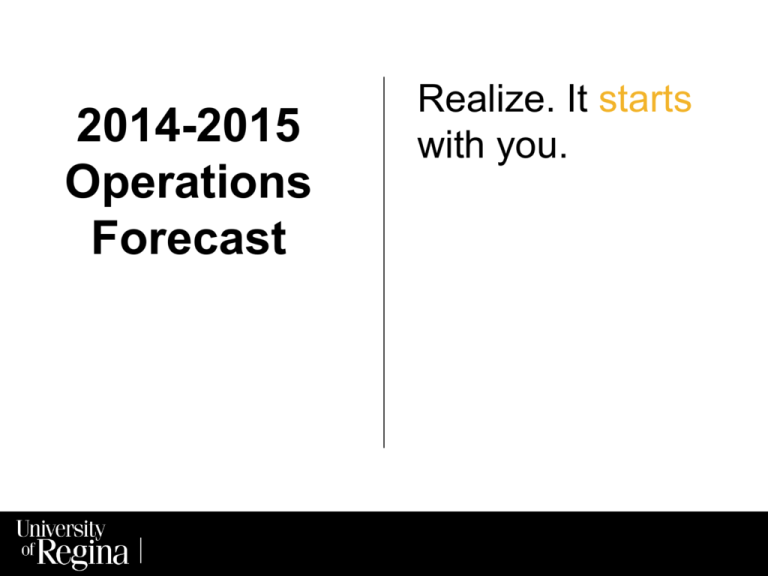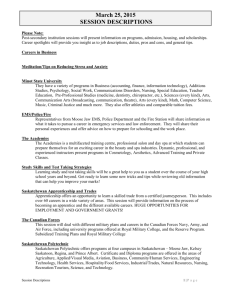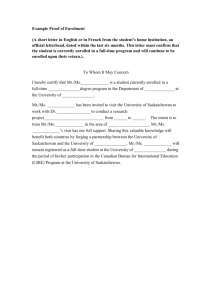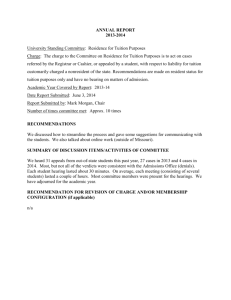Operations Forecast Presentation
advertisement

2014-2015 Operations Forecast Realize. It starts with you. Summary An increase in operating grant of 4.0% is required, assuming 4% tuition increases. Alternatively, with a 4.9% operating grant increase the University could hold tuition and fee increases to 2%. A variety of undesirable outcomes for the University, its students and stakeholders would result from operating grant increases at 0 or 2%. An additional $1 million in operating funding will complete the roll-out of the Nursing program and $150,000 will fund the masters’ program for Nurse Practitioners (10 seats). 2 Summary (cont.) Adequate building rehabilitation and renovation in a planned, cost-effective manner is now impossible. Sustaining Capital Funding has dropped to a level that funds only emergency repairs. A substantial increase in this funding is urgently required if unsustainable long-term liabilities are to be avoided. The renewal of the College Avenue Campus (CAC) is the University’s number one capital priority. $13.3 million in additional capital funding will complete the financing package for the residence and childcare project, now well underway. 3 Summary (cont.) Proposed new initiatives that will produce outcomes consistent with the Saskatchewan Plan for Growth include four proposed operating projects and the CAC Renewal Project. The University of Regina continues to enhance the sustainability of its operations through a wide variety of measures. 4 Students from around the world 5 The U of R is growing Enrolments have grown in 2013-14 for the fifth consecutive year to all-time high: over 13,300. Credit hours up 3%. The Nursing program is beginning its third year, fully subscribed, and with a new site in Swift Current. FNUniv enrolments are up at least 10 per cent. Self-declared Aboriginal students will exceed 11% of enrolments. International enrolments are at 1,600 this year,12% of the student body and up over 10% from last year. As a result of a modest advertising campaign, registrations from Calgary students grew 230% (30 students). 6 Nursing in Swift Current 7 Services expand to support students New Aboriginal Student Centre facility and Honouring our Future Entrance Bursary UR Guarantee participation at all-time high The Global Learning Centre offers the UR International Transitioning Program and many other supports. The Centre for Student Accessibility assisted 47% more students with disabilities in fall 2012 than 2009: 130 more students. Co-op education has placed 835 students in 2013 who are earning $9.7 million; 47% growth since 2005. These added services have costs. 8 The U of R is growing: CCE The Centre for Continuing Education, based on the College Avenue Campus, plays an essential role for the U of R, students and the community. 2012-13 was another year of growth Credit hours delivered by Continuing Education are up 32% in the past 2 years; now 23% of all U of R teaching On-line and televised enrolments up 54% in 2 years Night, early and weekend credit hours up 30% Off-campus credit hours up 14% Business and professional development (non-credit) growth of 18% Conservatory instruction up 14%; Lifelong Learning Centre up 34% 9 2014-15 operating grant proposal Base operating grant increase needed to sustain current operations: $3.9 million (4.0%) Plus $1 million final increase for Nursing program (to $6.5 million) and $150,000 for 10 seats in the Nurse Practitioner program Assumes 4.0% average tuition increase Total operating grant increase required to sustain operations + Nursing roll-outs: $5.1 million 10 Alternative scenario With a 4.9% base operating grant increase ($4.8 million) the University could hold tuition and fee increases to 2%. 11 Expected impact of an operating grant less than proposed A 2% grant increase would require a $2 million reduction in expenditures for a balanced budget. No grant increase (0%) would require a $4 million reduction in expenditures. Following $7 million of reductions in the last two years, this would be very difficult. We have largely exhausted our ability to reduce the budget without significant activity reductions. Each $1 million in budget reductions is equivalent to the non-replacement or termination of about 10 full-time equivalent employees. 12 Impact of further cuts Students will find it increasingly difficult to complete their degree programs in a timely manner or register in courses they need for their specialization. The University’s ability to address provincial priorities will be impaired: international student recruitment and retention, contributions to innovation, advancement of First Nations and Métis learners, applied learning opportunities, distributed and collaborative course delivery, etc. Increasing disquiet among faculty, staff and students will detract from students’ learning experiences and the University’s recruiting success. 13 Urgent need for sustaining capital The sustaining capital grant is essential for • physical plant renewal and adaptation, • for addressing a major backlog of plant deferred maintenance, and • for equipment and furniture upgrades and replacements. All are necessary to provide a modern, functional and appropriately equipped environment for student learning. Sustaining capital funding has dropped to levels where only emergency repairs are possible. Planned use of the funds is impossible. Costs put further pressure on the operating budget 14 Funding has not kept pace with building growth 15 Even new buildings require spending 16 Opening of expanded Aboriginal Students Centre in RIC 17 Funding today is only 35% of the purchasing power of 2005 funding 18 Facilities are deteriorating 23 per cent of University’s roofs are failing, with over 60 roof leaks occurring in locations that cannot be repaired without full replacement. Over $20 million is required for roof replacement alone. Similar situations occur with respect to building envelopes (windows, wall systems), HVAC systems, life safety systems, wiring, and plumbing. Past expenditures have dealt with only 25% of the needs of the aging facilities. Deferred maintenance and recapitalization exceed $300 million. 19 20 21 22 23 24 Risks As deferred maintenance increases so too does the risk of disrupting the academic mission in the University. Student experience Safety Financial costs escalate Reputation suffers, affects recruitment 25 Sustaining capital: what is needed Restore sustaining capital funding to 2009/10 level (adjusted for inflation): $10.2 M or 1.07% of CRV (current replacement value) Grow funding to DesRosier’s recommended lower boundary of prudent provision:1.3% of CRV This funding level is required to keep up. Periodic large investments are needed to catch up (e.g., CAC). 26 Major capital: residence and child care project Funding support from SaskHousing and Ministry of Education has project well underway. Tender outcomes presenting challenges: value engineering has been undertaken. Additional funding of $13.3 million required to complete the funding package. 27 Construction is underway 28 College Avenue Campus Renewal Number one capital priority A transformative project: efficiency, accessibility, growth, revitalization, community engagement University fundraising continues with over $3.6 million raised. Request: $5 million for each of 5 years Will be more than matched by the University “The purpose of growth is to secure a better quality of life for Saskatchewan people.” (The Saskatchewan Plan for Growth) 29 Historic beginnings, a century old 30 A vision: renewed and revitalized 31 New initiatives Four other projects have been identified that leverage University of Regina strengths: The Collaborative Centre for Justice and Safety Chronic pain treatment Clean energy technologies Transitions initiatives for student success New opportunities for students, engaging world-class faculty All of the projects support the Saskatchewan Plan for Growth 32 Sustainability/efficiency measures A balanced 2013-14 budget with reduced real funding Academic program review has refreshed programming, terminated low enrolment programs Program innovation in many areas Revised registration, classroom scheduling and recruiting processes Lean projects: five conducted, more on the way Increased use of technology for efficiencies Vacancy management and control of sessional appointments 33 The 2013-2014 university budget Budget cuts of 3 per cent to budget units: $3.5 million About 20 faculty and staff positions were eliminated. Reductions of about $1.7 million in discretionary budgets through cuts in sessional teaching and non-salary expenditures No allowance to most unit budgets for inflationary increases for material and supplies Growing academic units received 5 faculty positions and 4 support staff positions $350,000 expenditures shifted to operating from sustaining capital 34 Student fees: affordability For Canadian students, the U of R’s tuition plus mandatory fees are less than those at all but 14 of 57 English language public universities in Canada. Graduate tuition in Saskatchewan is among the lowest in the country, well below the national average. With the Saskatchewan Advantage Scholarship and the graduate retention program, U of R undergraduates who graduated from a Saskatchewan high school after 2011 are able to attend almost tuition-free. Student/graduates in Arts have a net tuition cost of $290. 35 Undergraduate tuition and fees (Average of 1st year Arts program by province, 2013-14) University/Region Average Tuition Memorial University of Newfoundland $3,063 Manitoba Universities $4,928 BC Universities $5,229 University of Regina $6,038 University of Saskatchewan $6,050 University of PEI $6,374 Alberta Universities $6,644 Ontario Universities $6,904 New Brunswick Universities $6,981 Nova Scotia Universities $7,182 Quebec Universities (English speaking) $7,558 Source: University of Regina, Office of Resource Planning. Includes mandatory additional fees. Quebec figures are for Canadian out-of-province students. 36 Conclusion The University of Regina has been successfully pursuing its vision and implementing its strategic plan with significant new levels of achievement. The University of Regina’s direction and activities are strongly aligned with the Saskatchewan Plan for Growth. An appropriately resourced University of Regina (including funding for new initiatives) is essential for continued success. A restoration of the purchasing power of sustaining capital funding is urgently required to protect the infrastructure of the University and the quality of its teaching and research activities. 37







